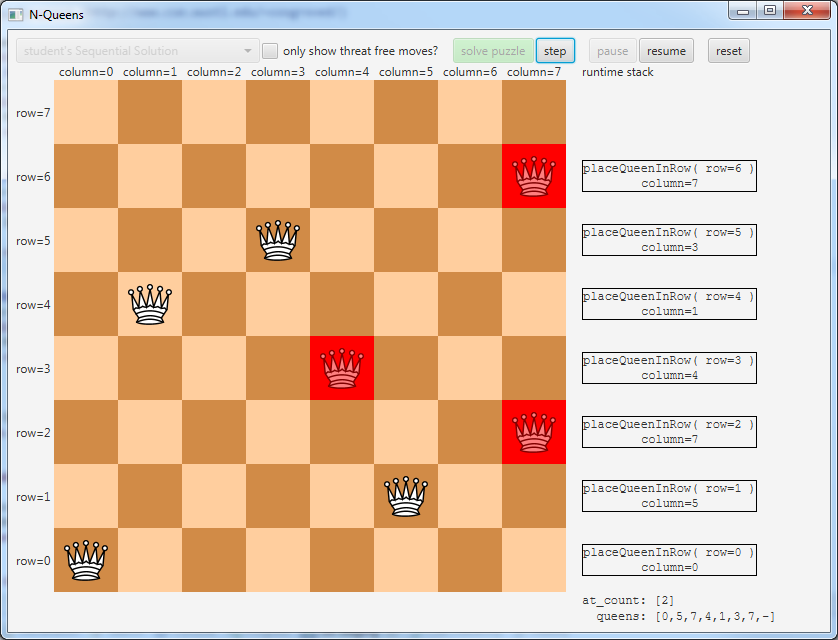N-Queens/Sudoku Assignment
Contents
Motivation
Not everything in the world should be divided and conquered. Backtracking is a powerful technique which can be readily parallelized. We will gain experience with backtracking by solving the N-Queens problem and Sudoku in parallel.
N-Queens in particular can be used to explain the call stack as the chessboard *IS* the call stack. Whoa.
Further, by employing constraint propagation and search we can dramatically improve performance for problems like Sudoku.
Background
The n-queens problem is a fundamental coding puzzle which asks: how can N queens be placed on an NxN chessboard so that they cannot attack each other? In chess, a queen can move horizontally, vertically, and diagonally across the board. Thus, to solve the n-queens problem, we must effectively figure out how to place the queens in such a way that no two of them occupy the same row, column, or diagonal.
We will be using a similar algorithm to solve a Sudoku puzzle. A Sudoku puzzle is composed of a 9-by-9 grid of squares. This grid is also divided into 9 large boxes, each of which is a 3-by-3 of the smaller squares. In a completed puzzle, each of the smaller squares contains a single number from 1 to 9 (inclusive). However, if a square contains a given number, that same number cannot be anywhere else in the same row, column, or box. Thus, for Sudoku, we are given an incomplete board and must fill in the remaining squares while meeting these requirements. For more explanation, take a look at Peter Norvig's essay about solving Sudoku.
In this assignment, you will implement solutions to both the n-queens and Sudoku problems.
Code To Implement
N-Queens
Sequential Solution
| class: | DefaultImmutableQueenLocations .java | |
| methods: | createNext getColumnOfQueenInRow getRowCount getBoardSize isNextRowThreatFree |
|
| package: | nqueens.lab | |
| source folder: | student/src/main/java |
method: public DefaultImmutableQueenLocations createNext(int column) ![]() (sequential implementation only)
(sequential implementation only)
method: public int getColumnOfQueenInRow(int row) ![]() (sequential implementation only)
(sequential implementation only)
method: public int getRowCount() ![]() (sequential implementation only)
(sequential implementation only)
method: public int getBoardSize() ![]() (sequential implementation only)
(sequential implementation only)
method: public boolean isNextRowThreatFree(int column) ![]() (sequential implementation only)
(sequential implementation only)
DefaultImmutableQueenLocations
| class: | DefaultImmutableQueenLocations.java | |
| methods: | createNext getColumnOfQueenInRow getRowCount getBoardSize |
|
| package: | nqueens.lab | |
| source folder: | student/src/main/java |
method: private static void placeQueenInRow(MutableInt count, MutableQueenLocations queenLocations, int row) ![]() (sequential implementation only)
(sequential implementation only)
Tips
N-Queens
There are three classes you will need to modify: DefaultImmutableQueenLocations.java, SequentialNQueens.java, and ParallelNQueens.java. Start with QueenLocations and then we recommend moving on to the sequential solution before the parallel one. Take a look at the javadocs to see what everything does and what you will need to implement.
A couple of notes and common issues:
- As
ImmutableQueenLocationsis immutable, you will need to create a new instance of the object whenever you move on from one row to the next. This is wherecreateNextcomes in, along with the private constructor of this class. - The
isNextRowThreatFreemethod can easily be completed with a method inAbstractQueenLocations. Refer to that for help. - The sequential solution uses
MutableQueenLocationswhile the parallel solution uses your implementation ofImmutableQueenLocations. Be careful to use the correctQueenLocationsimplementation. - As the name suggests,
placeQueenInRowwill go through the columns of the given row to check if a queen can fit in that location. If it can, it will set that value inMutableQueenLocations. If the examined row is that last row of the board, you have found one valid solution to the n-queens problem. Update the correct parameter accordingly. Otherwise, recurse and keep going until you reach the last row. - For the parallel implementation of
placeQueenInRow, we are using the "one-finish" pattern. Do not callfinishin the recursive method. - The syntax for instantiating a
FinishAccumulatorofIntegeris:FinishAccumulator<Integer> acc = newIntegerFinishAccumulator(NumberReductionOperator.SUM); - The syntax for using a
FinishAccumulatoris:finish(register(acc), () -> { //body });
Sudoku
Coming Soon
Testing Your Solution
Visualization
N-Queens
| class: | NQueensVizApp.java | VIZ |
| package: | nqueens.viz.solution | |
| source folder: | student/src//java |
Sudoku
| class: | SudokuSolutionApp.java | VIZ |
| package: | sudoku.viz.solution | |
| source folder: | student/src//java |
Correctness
There is a top-level test suite comprised of sub test suites which can be invoked separately when you want to focus on one part of the assignment.
top level
| class: | BacktrackTestSuite.java | |
| package: | backtrack.lab | |
| source folder: | testing/src/test/java |
sub
| class: | NQueensTestSuite.java | |
| package: | nqueens.lab | |
| source folder: | testing/src/test/java |
| class: | SudokuTestSuite.java | |
| package: | sudoku.lab | |
| source folder: | testing/src/test/java |
Rubric
As always, please make sure to cite your work appropriately.
Total points: 100
N-Queens subtotal: 40
- Correct ImmutableQueenLocations (10)
- Correct sequential implementation (10)
- Correct parallel implementation (20)
Sudoku subtotal: 50
- Correct ImmutableSudokuPuzzle (10)
- Correct SquareSearchAlgorithm (15)
- Correct ParallelSudoku (25)
Whole project:
- Clarity and efficiency (10)

